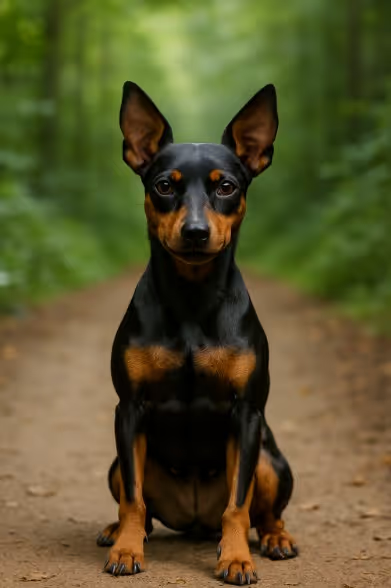The Miniature Pinscher, often called the “King of Toys,” is a spirited, compact breed known for its confident strut, fearless personality, and watchdog instincts. Despite its small size, the Miniature Pinscher thrives with active families or singles who can match its energy. It's a great companion for Canadian homes seeking a bold, entertaining, and low-maintenance dog with a big personality.

Despite looking like a smaller Doberman, the Miniature Pinscher is an older and distinct breed. Originating in Germany several centuries ago, it was bred to hunt rats in homes and stables. A mix of Dachshund, Italian Greyhound, and German Pinscher ancestry, the Min Pin gained popularity in Europe in the 19th century and was introduced to North America in the 1900s. It is now a popular toy breed, admired for its confidence and liveliness.
The Miniature Pinscher is sleek, muscular, and compact, with an unmistakable high-stepping gait.
Min Pins are low-maintenance and easy to groom.
This small breed packs a ton of energy and needs consistent activity.
The Min Pin is smart but stubborn—training takes consistency and confidence.
A balanced diet keeps this compact athlete in top form.
Miniature Pinschers are generally healthy but may be prone to a few conditions.
Look for ethical breeders or small breed rescues in Canada.
Are Miniature Pinschers good apartment dogs?
Yes, with daily exercise and mental stimulation. They’re active indoors and thrive in compact spaces.
Do Min Pins get along with kids?
They can, with supervision. Best for families with older, respectful children.
Are Miniature Pinschers hypoallergenic?
No, but they shed minimally and are easy to groom.
Do Miniature Pinschers bark a lot?
They’re alert and vocal—early training helps manage barking.
Are Min Pins hard to train?
They’re intelligent but independent—firm, consistent training is key.
Can Miniature Pinschers be left alone?
They don’t like being alone for long. Crate training and enrichment toys can help.
What makes the Min Pin gait unique?
They have a “hackney” gait—lifting front legs high, almost like a trotting horse.
Do they need a coat in winter?
Yes! They’re sensitive to cold and need sweaters or jackets in Canadian winters.